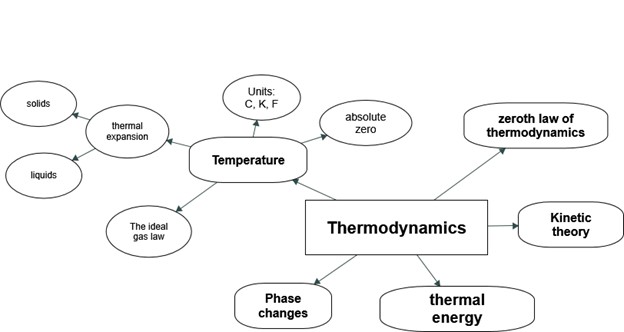41 Main Ideas
Week 11
Temperature, Kinetic Theory, and the Gas Laws
Concept Map of the Week

Note: image by Chudaeva, E. (2022).
Concept Trailer
Phase Changes
Watch this video.
Then watch the video again and answer the following questions:
- Define the amount of heat required to change temperature of an object of mass m.
- Define the amount of heat required to melt a piece of ice of mass m.
- What states of matter are mentioned in this video?
- What changes in states of matter are present in this video?
- How forms of mechanical energy discussed earlier in the course are connected with the concepts of temperature and phase change?
Key Terms
Review the following key terms (Glossary chapter 13):
absolute zero
the lowest possible temperature; the temperature at which all molecular motion ceases
Avogadro’s number
NA , the number of molecules or atoms in one mole of a substance
Boltzmann constant
k , a physical constant that relates energy to temperature
Celsius scale
temperature scale in which the freezing point of water is 0ºC and the boiling point of water is 100ºC
critical point
the temperature above which a liquid cannot exist
critical pressure
the minimum pressure needed for a liquid to exist at the critical temperature
critical temperature
the temperature above which a liquid cannot exist
Dalton’s law of partial pressures
the physical law that states that the total pressure of a gas is the sum of partial pressures of the component gases
degree Celsius
unit on the Celsius temperature scale
degree Fahrenheit
unit on the Fahrenheit temperature scale
Fahrenheit scale
temperature scale in which the freezing point of water is 32ºF and the boiling point of water is 212ºF
ideal gas law
the physical law that relates the pressure and volume of a gas to the number of gas molecules or number of moles of gas and the temperature of the gas
Kelvin scale
temperature scale in which 0 K is the lowest possible temperature, representing absolute zero
mole
the quantity of a substance whose mass (in grams) is equal to its molecular mass
phase diagram
a graph of pressure vs. temperature of a particular substance, showing at which pressures and temperatures the three phases of the substance occur
PV diagram
a graph of pressure vs. volume
sublimation
the phase change from solid to gas
temperature
the quantity measured by a thermometer
thermal energy
the average translational kinetic energy of a molecule
thermal equilibrium
the condition in which heat no longer flows between two objects that are in contact; the two objects have the same temperature
thermal expansion
the change in size or volume of an object with change in temperature
vapor
a gas at a temperature below the boiling temperature
vapor pressure
the pressure at which a gas coexists with its solid or liquid phase
zeroth law of thermodynamics
law that states that if two objects are in thermal equilibrium, and a third object is in thermal equilibrium with one of those objects, it is also in thermal equilibrium with the other object
More terms can be found in the textbook Glossary.

